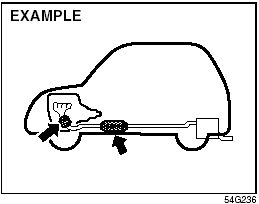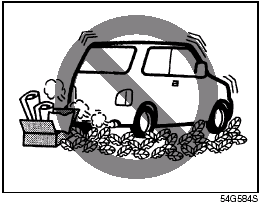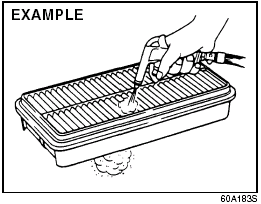Suzuki Grand Vitara: Catalytic Converter

Catalytic Converter
The purpose of the catalytic converter is to minimize the amount of harmful pollutants in your vehicle’s exhaust. Use of leaded fuel in vehicles equipped with catalytic converters is prohibited by federal law, because lead deactivates the pollutantreducing components of the catalyst system. The converter is designed to last the life of the vehicle under normal usage and when unleaded fuel is used. No special maintenance is required on the converter. However, it is very important to keep the engine properly tuned. Engine misfiring, which can result from an improperly tuned engine, may cause overheating of the catalyst. This may result in permanent heat damage to the catalyst and other vehicle components.
CAUTION: To minimize the possibility of catalyst or other vehicle damage:
• Maintain the engine in the proper operating condition.
• In the event of an engine malfunction, particularly one involving engine misfire
or other apparent loss of performance, have the vehicle serviced promptly.
• Do not shut off the engine or interrupt the ignition when the transmission is
in gear and the vehicle is in motion.
• Do not try to start the engine by pushing or towing the vehicle or coasting down
a hill.
• Do not idle the engine with any spark plug wires disconnected or removed, such
as during diagnostic testing.
• Do not idle the vehicle for prolonged periods if idling seems rough or there are
other malfunctions.
• Do not allow the fuel tank to get near the empty level.

 WARNING: Be careful where you
park and drive; the catalytic converter and other exhaust components can get very
hot. As with any vehicle, do not park or operate this vehicle in areas where combustible
materials such as dry grass or leaves can come in contact with a hot exhaust system.
WARNING: Be careful where you
park and drive; the catalytic converter and other exhaust components can get very
hot. As with any vehicle, do not park or operate this vehicle in areas where combustible
materials such as dry grass or leaves can come in contact with a hot exhaust system.
Improving Fuel Economy
The following instructions will help you improve fuel economy.
Avoid excessive idling
If you are to wait for more than a minute while you are parked, stop the engine and start it again later. When warming up a cold engine, allow the engine to idle until the temperature gauge pointer comes up to the “C” position. In this position, the engine is sufficiently warm for starting off.
Avoid “jackrabbit” starts
Fast starts away from lights or stop signs will consume fuel unnecessarily and shorten engine life. Start off slowly.
Avoid unnecessary stops
Avoid unnecessary deceleration and stopping. Try to maintain a slow, steady speed whenever possible. Slowing down and then accelerating again uses more fuel.
Keep a steady cruising speed
Keep as constant a speed as road and traffic conditions will permit.

Keep the air cleaner clean
A dirty air cleaner will cause the fuel injection system to supply too much fuel to the engine for the amount of air being supplied. The result is waste of fuel due to incomplete fuel burning.
Keep weight to a minimum
The heavier the load, the more fuel the vehicle consumes. Take out any luggage or cargo when it is not necessary.
Keep tire pressure correct
Underinflation of the tires can waste fuel due to increased running resistance of the tires. Keep your tires inflated to the correct pressure shown on the label located below the driver’s side door latch striker.
See also:
Getting Assistance Outside the U.S. and Canada
Before exporting your vehicle to a foreign country, contact the
appropriate foreign embassy or consulate. These officials can inform you
of local vehicle registration regulations and where to find unleaded fuel.
If you cannot find unleaded fuel ...
Four Wheel Drive (4WD) System (if equipped)
WARNING: For important information regarding safe operation
of this type of vehicle, see Preparing to drive your vehicle in
this chapter.
Your vehicle is equipped with an intelligent 4WD System that
continuously monitors vehicle conditions and a ...

 Tire Pressure Monitoring System (TPMS) (if equipped)
Tire Pressure Monitoring System (TPMS) (if equipped)